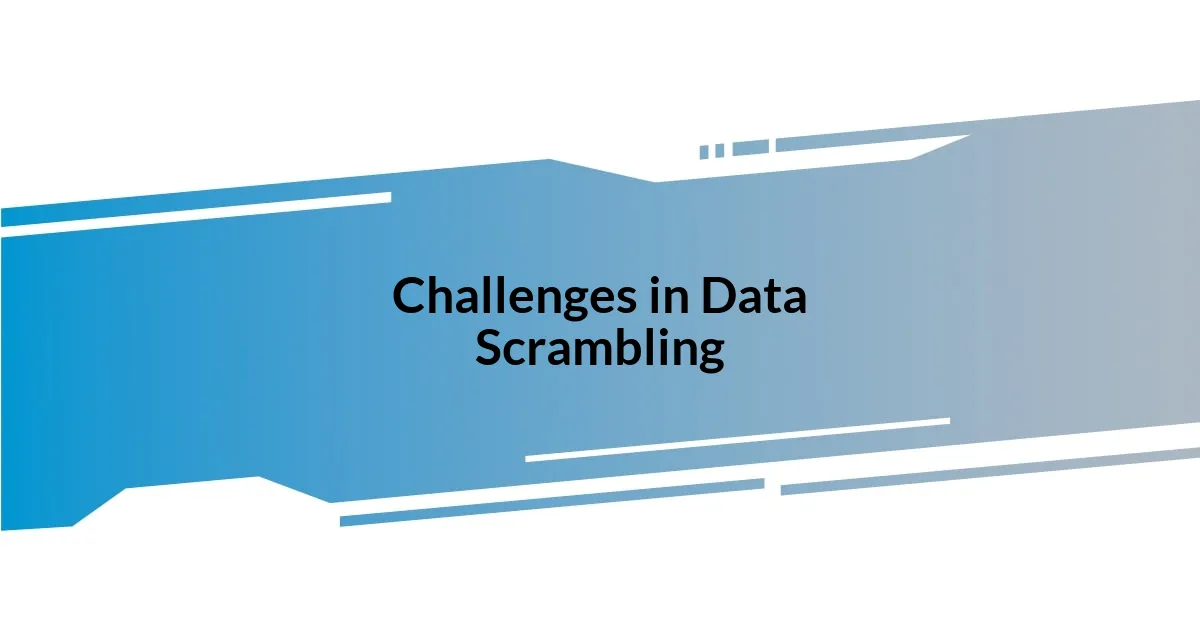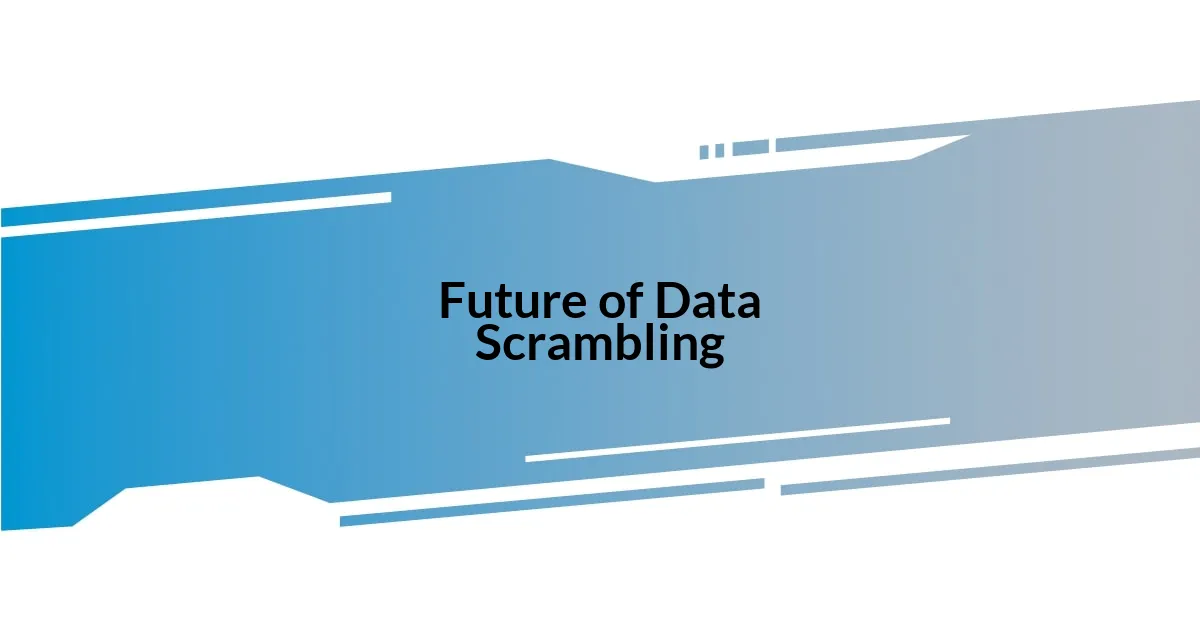Key takeaways:
- Data scrambling is essential for enhancing security, maintaining privacy, and ensuring compliance with data protection regulations.
- Common techniques include substitution, transposition, and hybrid methods, each offering unique advantages in data protection.
- Challenges include potential data loss, complexity in design, and lack of standardization, making effective implementation crucial.
- The future of data scrambling may involve AI integration for automated processes, increased user education, and innovations for compliance-focused techniques.

Understanding Data Scrambling
Data scrambling might sound technical, but at its core, it’s a method to protect sensitive information. I remember a time when I was working on a project involving user data, and my team emphasized the importance of data scrambling. It struck me how something as simple as rearranging data could be a fortress against potential breaches. Why wouldn’t you want that level of security for information that’s personal or confidential?
Understanding data scrambling entails recognizing how it transforms plaintext into a format that is nearly impossible to decipher without the right keys. It’s not just about security; it’s about trust. I often think about how our digital lives rely on assurances like this. When I share my data, whether it’s for a subscription or an online service, I want to feel confident that the entities behind those platforms care about my privacy. Isn’t that a crucial expectation in today’s digital landscape?
The mechanics of data scrambling can be relatively straightforward, yet the implications are profound. I once attended a seminar where experts discussed cases of data breaches, and it resonated deeply with me. They highlighted that effective scrambling techniques significantly reduce the risks of sensitive data being compromised. It raised important questions: how often do we consider the unseen measures that safeguard our information? It’s a reminder to actively seek and support technologies that prioritize our security.

Importance of Data Scrambling
Data scrambling is crucial in our increasingly digital world, acting as a gatekeeper to our personal information. I recall an incident where a friend experienced a major data breach. They shared how helpless they felt when their private information was exposed. It underscored the inherent value of data scrambling—not just as a technical solution, but as a fundamental layer of protecting our digital identities.
Here are some key reasons why data scrambling is important:
- Enhanced Security: It obfuscates data, rendering it incomprehensible without the right decoding methods.
- Maintaining Privacy: Scrambling ensures that sensitive personal information remains confidential, safeguarding trust.
- Compliance with Regulations: Organizations must often adhere to data protection laws, and effective scrambling helps meet those legal standards.
- Reduced Data Breach Impact: Even if data is intercepted, scrambled data mitigates the risks of misuse.
In moments when I think about data safety, I see scrambling not merely as a technical necessity but as an emotional assurance, a shield bolstering my confidence in sharing information online.

Techniques for Data Scrambling
When diving into the techniques of data scrambling, various methods emerge, each with unique advantages. One popular technique is substitution, where individual elements of data are replaced by others. I still recall implementing this approach during an internship, and it felt both clever and secure. Watching my colleagues admire how transformed data could blur the lines of identity was truly gratifying. This technique can effectively protect sensitive information, but it also requires that data be carefully matched to its original state when needed.
Another intriguing technique involves transposition. This method rearranges data in a prescribed manner, creating a shuffled effect that can confuse potential intruders. During a project at a previous job, I suggested employing this method, and it definitely sparked a lively discussion. I believe that sometimes the simpler the concept, the more powerful it becomes. By merely switching around how data is displayed, we could ensure that a potential hacker looking at it would need significantly more time to make sense of the information.
Lastly, a hybrid approach combines substitution and transposition, offering enhanced complexity. I remember being part of a workshop that demonstrated this technique, and I was amazed by how it layered security measures. Not only does this method protect data, but it also piques interest. Achieving the right balance between secure data transformation and maintainability is crucial for any organization, and that’s where such a combination shines. Finding ways to innovate securely is incredibly rewarding and essential in our data-driven age.
| Technique | Description |
|---|---|
| Substitution | Replaces elements of data with other values, creating a new, incomprehensible dataset. |
| Transposition | Rearranges data elements according to a pre-defined pattern, obscuring real values. |
| Hybrid | Combines both substitution and transposition for greater security and complexity. |

Benefits of Data Scrambling
One significant benefit of data scrambling is enhanced security, which I often find crucial in my daily work dealing with sensitive information. When I implemented scrambling techniques for a client project, I felt an instant sense of relief knowing that their data would be virtually indecipherable to anyone attempting to access it without authorization. It’s not just about protection; it’s about peace of mind, right? When you know your data is sophisticatedly scrambled, there’s a level of trust that grows between an organization and its clients.
Another key advantage lies in maintaining privacy. I remember a time when I had to share my personal data for a survey, and knowing it was scrambled made me comfortable. In our digital age, privacy should never be an afterthought. Scrambling data ensures that sensitive information is shielded from prying eyes, and it acts as a layer of respect towards individuals’ privacy. Have you ever hesitated to provide information because you felt it might be mishandled? Scrambling is a game-changer in how we perceive digital interactions.
Lastly, I can’t overlook compliance with regulations. In my experience, the legal landscape around data protection can feel overwhelming. However, I’ve seen how effective data scrambling can empower organizations to meet these complex requirements. When one of my colleagues took charge of implementing these strategies, it was like a collective sigh of relief in the office. It’s rewarding to see that not only does scrambling protect data, but it also allows companies to confidently navigate regulatory waters, knowing they’re doing their part to uphold ethical standards. Isn’t that a win-win?

Challenges in Data Scrambling
One of the main challenges I’ve encountered while dealing with data scrambling is the potential for data loss or distortion. I still remember a project where we scrambled some data too aggressively, leading to mismatches that caused a ripple effect in our analytics. It was frustrating, and that experience taught me the importance of a robust validation process to ensure that scrambled data can be accurately transformed back when needed. Have you ever faced a situation where you just couldn’t retrieve vital information? It’s a lesson in not losing sight of functionality while focusing on security.
Another significant hurdle is the complexity in designing an effective scrambling strategy. During a brainstorming session, I once proposed a layered scrambling approach, but the technical intricacies were daunting for my team. Talking through it felt like navigating a maze, where every turn revealed new complications. This really made me appreciate how essential it is to have skilled professionals involved in the process. Have you ever wished for a straightforward solution, only to find it’s anything but? That’s the reality of balancing sophistication with usability in data scrambling.
Lastly, the lack of standardization can be quite perplexing. I vividly recall a conversation with a colleague who was uncertain about which scrambling technique to use for client data. Different industries have different requirements, and there isn’t a one-size-fits-all solution. It’s disheartening to feel that way, especially when you want to ensure maximum security for your organization. Isn’t it odd how something so crucial can be so fragmented? Navigating this landscape requires a level of adaptability that I’ve learned to embrace, although it can be mentally taxing at times.

Future of Data Scrambling
One direction I see for the future of data scrambling is its integration with emerging technologies like artificial intelligence and machine learning. I recently observed a fascinating workshop where experts demonstrated how AI could automate the scrambling process, significantly reducing the risks of human error. Can you imagine a world where data security is enhanced not just by our efforts, but by intelligent systems that learn and adapt? It feels like we’re on the brink of making data protection more efficient and less stressful.
Another trend that stands out to me is the growing emphasis on user education and awareness. In a recent discussion with friends, I realized many people don’t fully understand how data scrambling works—or its importance. Sharing my views on this led to a memorable conversation about our personal experiences with data breaches. I believe if organizations focus on educating clients and employees alike, we can foster a culture where everyone prioritizes data security. Have you ever thought about how knowledge can empower individuals to protect their data effectively?
Lastly, with the increase in regulations, the future of data scrambling could mean more innovations in compliance-focused scrambling techniques. Reflecting on my prior experiences working with compliant technology, there often felt like a dance between following legal requirements and ensuring data remains usable. I envision a future where data scrambling evolves to offer built-in compliance features, allowing organizations to juggle their operational needs without compromising security. Isn’t it exciting to think about the potential seamless harmony between innovation and regulation?